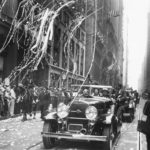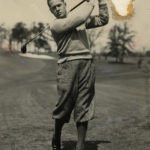
Bobby Jones (2021)
About Bobby Jones (2021)
Bobby Jones? New York? Really?
Surely if there is any metropolitan area associated with the greatest golf figure of the 1920s – often called the Golden Age of Sports – it’s that of Atlanta, Georgia, where he grew up, learned the game, practiced law, and lived out his life. If not Atlanta, then perhaps it’s a place 145 miles east, where he created the Augusta National Golf Club and gave his imprimatur to the annual invitational golf tournament held there most Aprils. Or nearly 4,000 miles further northeast, to the town of St. Andrews, where he declared in 1958, “I could take out of my life everything except my experiences at St. Andrews, and I would still have had a rich and full life.”
Despite these clear facts, and the man’s own gracious statement to the Scots who had just declared him an Honorary Burgess (including the right “to catch rabbits, to take divots, and to dry one’s washing upon the first and last fairways of the Old Course”), it can be argued that our Met Area played as consequential a role in Jones’s life and career as any other place save his birthplace.
Ask a knowledgeable golf fan about Jones’s accomplishment in this region and you’ll likely hear about two legendary moments: a tickertape parade up Broadway after he won the Grand Slam in 1930; and the curling, treacherous, fourteen-foot putt on Winged Foot’s 18th green he needed to make just to force a playoff in the 1929 U.S. Open, a playoff he won by 23 strokes over 36 holes. But Jones had many other experiences and adventures in the Met Area through the years, all the way back to when he was a hot-headed teenager. Consider:
- In 1917, the fifteen-year-old Jones partnered with his childhood friend Perry Adair in a match at Hackensack CC to raise money for the Red Cross. A year later, an exhibition tour with Adair, Alexa Stirling, and Elaine Rosenthal made stops at Wykagyl, Montclair, and Essex County for four-ball matches. In 1920, Jones took part in a match at Morris County GC against Harry Vardon and Ted Ray on the latter pair’s American Tour leading up to Ray’s victory in the 1920 US Open.
- Jones’s first appearance in a national semifinal came at Engineers GC in the 1920 U.S. Amateur. The event marked the first match between two of the greatest American amateurs, Jones and Francis Ouimet; the 1913 U.S. Open champ prevailed, 6 & 5, before falling in the final to Chick Evans. Jones would meet Ouimet in two more U.S. Am semifinals, in 1926 and 1927, winning both.
- He played on the U.S. side in five of the first six Walker Cups, including the first two on U.S. soil in 1922 at National Golf Links of America and 1924 at Garden City Golf Club. He earned three points in his four matches during those two Cups; the first-day foursomes that he and William Fownes, Jr., lost at Garden City by one hole to Michael Scott and Robert Scott, Jr., was the only point lost by Jones in ten career matches.
- In the early ‘20s Jones built a reputation as someone who could not close the door in big events. Look no further than the 1923 U.S. Open at Inwood CC: He finished 5-5-6 to turn a romp into a nail-biter requiring a playoff with Bobby Cruickshank. The lead seesawed throughout the extra round, and they came to 18 dead even. Cruickshank topped his drive, and soon Jones faced a 190-yard shot over water to the green; he ripped it to six feet from the flag, and at age 21 got his long-expected first major championship victory.
- The most famous single golf club in the world – Jones’s putter, “Calamity Jane” – is itself a New Yorker. Jim Maiden, the pro at Nassau CC and brother of Jones’s long-time mentor at East Lake in Atlanta, Stewart Maiden, played a tune-up round with Jones before the ’23 Open. Jones was struggling with his putter, and Maiden brought out a replacement that he himself had been using and had given its nickname. Jones immediately began making putts with it, and used it to win his first major and the eleven others that followed.
- The confetti-strewn Manhattan ride Jones took through what’s now called the Canyon of Heroes was not, in fact, in celebration of the 1930 Grand Slam. Only half of that quadrilateral had been achieved when Jones returned from Great Britain on the Aquitania: the British Open and Amateur Championships. It was the second time he’d been given such a welcome by the mayor and the people of New York: Four years earlier, a similar procession marked Jones’s arrival in the U.S. after winning his first [British] Open Championship. Jones is one of eleven individuals (and the only athlete) to receive more than one such tickertape parade in New York; the others include Amelia Earhart, Dwight D. Eisenhower, Charles De Gaulle, Haile Selassie, and John Glenn.
- The other major championship Jones played in the Met Area was the 1926 U.S. Amateur at Baltusrol, and the most remarkable thing about that event is that he didn’t win it. He was the two-time defending champion, medalist in stroke play, and reached the finals but lost to George Von Elm 2 & 1; Von Elm had been eliminated by Jones the two previous years, in the finals and semifinals respectively. Since Jones won the Am again in 1927 and 1928, a victory at Baltusrol might’ve meant five straight titles. As it is, his streak of five times in the finals, from 1924 to ’28, has never been matched (only Jerome Travers and Chick Evans even reached the finals five times period). Eight years later, Jones (and Ouimet) consulted with A.W. Tillinghast on modifications to the course in advance of the 1936 U.S. Open; he was made a non-resident member of the club in that latter year.
- He was also a member at Knollwood in the 1920s, and set the course record there in 1928. His friend Clifford Roberts, a successful Wall Street broker, was a member there as well; the two had met after Jones’s defeat at Baltusrol in ’26, when Roberts joined a group consoling the Atlantan. Roberts suggested that Baltusrol’s par-fives negated Jones’s length advantage, but Jones rejected any implication that he had lost for any reason other than Von Elm’s superior play. Roberts and Jones eventually teamed up to create Augusta National, with Roberts handling all aspects of the financing.
- Jones’s putt to make the playoff at Winged Foot in the ’29 Open was been aptly labeled “Golf’s Greatest Putt” by Grantland Rice in ***START ITAL***Sports Illustrated***END ITALS*** in 1954. On top of everything else about it, the putt saved Jones from the ignominy of blowing a six-shot lead with six to play. On the 25th anniversary of the putt, Winged Foot put together an exhibition four-ball in which Gene Sarazen and Johnny Farrell opposed Craig Wood and Tommy Armour – four U.S. Open champions, with Jones himself as the referee. On the eighteenth green, Jones pointed out where his ball had lain, and several luminaries – the four competitors, home pro Claude Harmon, Findlay Douglas (1898 U.S. Amateur champion and past president of the MGA and the USGA), Joe Dey (USGA Executive Director), and Homer Johnson (Winged Foot president) – all took a run at it, some of them more than once. Many came close, but nobody could hole it.
- One additional note about that consequential Saturday in 1929: According to Herbert Warren Wind, after Jones made the putt he stopped by the USGA tent to ask what time the playoff would begin. Told it was scheduled for nine o’clock, Jones, ever the thoughtful gentleman, said, “Why don’t we start at 10? Al [Espinosa] will want to go to church.”
Given all the foregoing, you might say that you could take out of Jones’s life everything except his experiences in the Met Area, and he still would have had a full and rich existence.
Leaving his mark on the Met Area…
The Met Area played as consequential a role in Bobby Jones’s life and career. From his days as a teenager, competing at Hackensack and Morris County, to the 1929 U.S. Open at Winged Foot, to the tickertape parade in NYC in his honor in 1930, Jones had many memorable moments throughout the area.
ADDITIONAL DETAILS & MULTIMEDIA
Life Events
- Date of Birth: March 17, 1902
- Date of Death: December 18, 1971
- Hometown: Atlanta, Ga.
Achievements
- Jones founded and help design Augusta National; he and fellow Knollwood member Clifford Roberts teamed up to build the course
- The most successful amateur golfer to compete at the national and international level with 34 tournament wins, including 7 Major titles
- Captured the “Grand Slam” in 1930, winning the U.S. Amateur, The Open Championship, U.S. Open, and The Amateur Championship in the same calendar year.
- Inducted into the World Golf Hall of Fame in 1974


